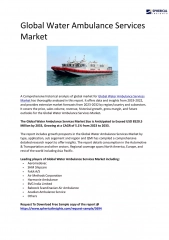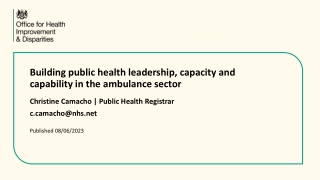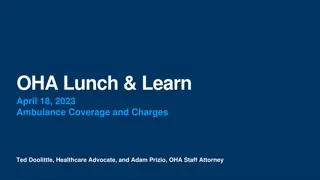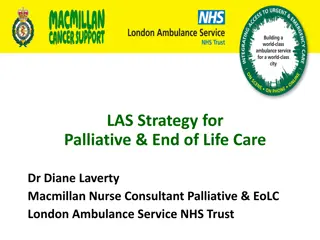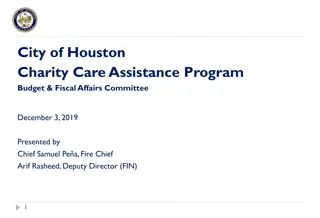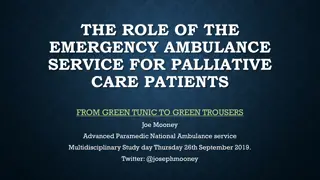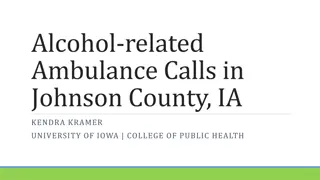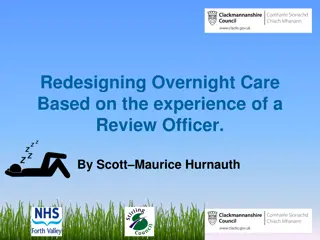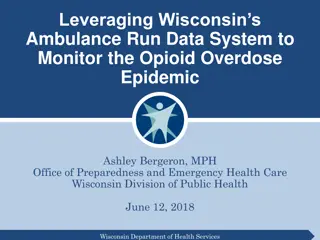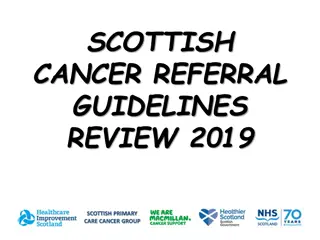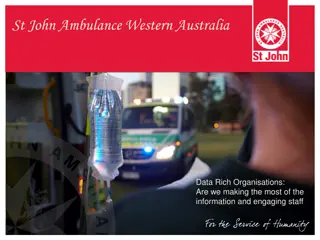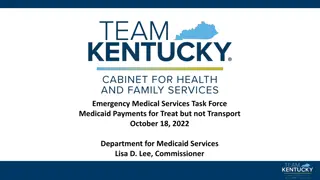Enhancing Urgent Care Services: Scottish Ambulance Service's Role in Redesigning Care Delivery
The Scottish Ambulance Service plays a crucial role in redesigning urgent care services to ensure equitable access to care, closer to home. Through collaboration and innovative models like the Flow Navigation Centre, they aim to improve response times and the referral process for better patient outcomes. Continuous improvement and learning cycles help optimize services and resource allocation for efficient care delivery.
Download Presentation

Please find below an Image/Link to download the presentation.
The content on the website is provided AS IS for your information and personal use only. It may not be sold, licensed, or shared on other websites without obtaining consent from the author. Download presentation by click this link. If you encounter any issues during the download, it is possible that the publisher has removed the file from their server.
E N D
Presentation Transcript
The role of the Scottish Ambulance The role of the Scottish Ambulance Service in the Redesign of Urgent Care Service in the Redesign of Urgent Care
A day in the life of the Scottish Ambulance A day in the life of the Scottish Ambulance Service Service
Whole System Collaboration Whole System Collaboration The role of the Scottish Ambulance Service in the delivery of a sustainable emergency, urgent and unscheduled care system Many providers, many interfaces - many opportunities How does whole system collaboration help?
Our response model Our response model
Continually enhancing our response Continually enhancing our response
Decision Support through NHS Grampian Flow Navigation Centre 'Everyone in Grampian receiving the right care, at the right time, in the right place based on their individual circumstances and needs'
Redesign Urgent Care SAS Work Stream FOCUSSED KEY OBJECTIVES Provide direct access for SAS clinicians to Flow Navigation Centre WHOLE SYSTEM FLOW AIM - Delivering Care closer to home for people requiring Urgent Care with equity of access to urgent , primary and community services Enhance ability for Clinician to refer to Primary Care Enhance ability for Clinicians to refer to Community Pathways Enhance ability for Clinicians to refer to Community Pathways Improve SAS Clinicians access to professional to professional advice Allow access and sharing information across health and care organisations
RAMP PDSA 1-4 LEARNING OUTCOMES Cycle 4 Test two weeks 9 5 pm Learning variation in referral pattern and understanding of process Cycle 3 test at weekend all crews. Is workload manageable, are calls appropriate, impact on other parts Learning 6 calls - 50 % calls to AMIA. Trak useful for documenting Cycle 2 Test one day all crews. Is workload manageable, are calls appropriate. Learning importance of effective communication Cycle 1 Test one day with 4 crews. Is workload manageable, are calls appropriate Learning 2 calls . Need Robust method of recording
RAMP PDSA 5 LEARNING OUTCOMES Total 27 patients referred from SAS to FNC over 7 days 9am - midnight Outcomes of SAS/FNC Decision Support Calls PDSA Cycle 5 9 8 8 7 7 6 6 5 4 3 2 2 2 1 1 1 0 ED AMIA Primary Care Surgery GAU Self Care Unknown
Patient Experience 84 year old who lived alone and had fallen at home 70 year old living alone with haematuria & abdominal pain Called 999 - SAS AP carries out virtual consultation. Access to TRAK - detailed history and virtual examination. Discussion with FNC Clinician and scheduled admission to Acute Medical Assessment Discharged home after 3 days, community care & follow up Called 999 and deemed suitable for Hear and Treat . SAS Clinician contacted AP in FNC with Comprehensive SBAR. AP discussed with Consultant Geriatrician and Hospital at Home Assessment arranged . SAS Clinician stood down and hospital admission avoided 49 year old woman with facial weakness calls 999. SAS Clinician reviewed patient with comprehensive neurological assessment with suspected resolved TIA. Discussion with FNC, comprehensive SBAR. Agreed patient not requiring conveyance. FNC arranged next day Scheduled Stroke Review/MRI and Aspirin prescription sent to patients pharmacy via Community Outpatient Prescription ( CoPPr )
SAS/FNC OUTCOMES 11 APRIL 1 MAY 2022 68 calls received at the FNC from SAS 49 non-conveyed = 72% 19 conveyed to ED = 28% Breakdown SAS Non-Conveyed Outcomes 13 12 7 6 5 2 2 1 1 Primary Care Self Care Advice Direct Ward Admission Minors Appointment FNC Consultant Unavailable Referred to GMED Reviewed by ANP Medication Change Crew already at ED
Redesign Urgent Care SAS Work Stream Update ACTIONS / TESTS Provide direct access for SAS clinicians to Flow Navigation Centre Implemented 17/1 WHOLE SYSTEM FLOW Explore FNC provide necessary links with Primary Care Enhance ability for Clinician to refer to Primary Care Delivering Care closer to home for people requiring Urgent Care with equity of access to urgent , primary and community services Enhance ability for Clinicians to refer to Community Pathways Enhance ability for Clinicians to refer to Community Pathways Now have Access H@H Improve SAS Clinicians access to professional to professional advice SAS AP/FNC Joint Working Allow access and sharing information across health and care organisations SAS Clinician Access to TRAK
Collaborative team supporting direct access for SAS clinicians to Flow Navigation Centre
Thank you A Collaborative Approach to ensuring 'Everyone in Grampian receives the right care, at the right time, in the right place based on their individual circumstances and needs'




